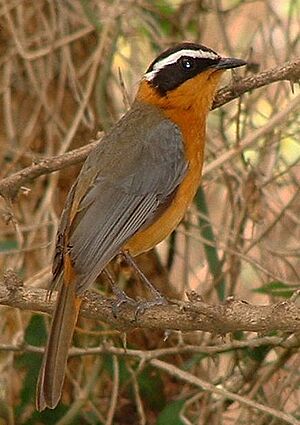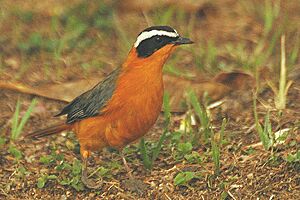White-browed robin-chat facts for kids
Quick facts for kids White-browed robin-chat |
|
|---|---|
 |
|
| Conservation status | |
| Scientific classification | |
| Genus: |
Cossypha
|
| Species: |
heuglini
|
The white-browed robin-chat (Cossypha heuglini) is a beautiful bird found in many parts of Africa. It's also known as Heuglin's robin. This bird is part of the Muscicapidae family, which includes many types of flycatchers and chats. You can find them living in forests near rivers, in thick bushes, and sometimes even close to people's homes.
Contents
About the White-browed Robin-Chat
This bird was first described in 1866. Its scientific name, heuglini, honors a person named Martin Theodor von Heuglin. There are a few slightly different types, or subspecies, of this bird found across Africa.
What Does It Look Like?
The white-browed robin-chat is about 19 to 20 centimeters (about 7.5 to 8 inches) long. It weighs between 29 and 51 grams, which is about the same as a few strawberries!
It has a black head and face, with a bright white stripe above its dark brown eye, like a white eyebrow. Its back is a mix of olive and grey-brown. The lower back area, called the rump, is a reddish-orange color. Most of its tail feathers are also reddish-orange, except for the two middle ones, which are olive-brown.
Its wings are grey-brown, and the feathers under its wings are reddish-orange. The underside of its body is a bright reddish-orange color. It has a black beak and legs that can be pinkish-brown, grey, or dark brown. Female robin-chats are usually a little smaller than the males.
Young robin-chats look a bit different. They have brown heads and reddish-brown marks on their backs. Their throats are pale, and their chests and bellies are a pale orange color.
Where Do They Live?
You can find white-browed robin-chats across a large area of Africa. This includes countries like Angola, Botswana, Kenya, South Africa, Tanzania, and many others.
They love living in forests near rivers and in thick bushes. They also adapt well to living near people, so you might spot them in gardens! In East Africa, they can live in places as high as 2,200 meters (about 7,200 feet) above sea level. However, in southern Africa, they usually stay below 1,000 meters (about 3,300 feet).
What Do They Eat?
The white-browed robin-chat enjoys a varied diet. They mostly eat insects like ants, termites, and beetles. They also snack on other small creatures like spiders. Sometimes, they will even eat small frogs or fruits. They also like to take baths in water!
Amazing Songs and Calls
These birds are known for their beautiful songs! They have different calls for different reasons. Their contact calls, which they use to talk to each other, sound like "pit-porlee" or "da-da-tee." If they sense danger, they make an alarm call that sounds like "takata-kata-kata."
Their most famous sound is their melodious song, which they often sing at dawn and dusk. It starts quietly and then gets louder. The song includes phrases like "pip-pip-uree" or "don't-you-do-it," which they can repeat many times. When a robin-chat sings loudly, it opens its beak wide, puffs out its chest, and its tail moves with each note! Sometimes, a pair of robin-chats will sing together in a duet.
Breeding and Life Cycle
White-browed robin-chats are monogamous, meaning a male and female bird stay together to raise their young. Near the Equator, they might breed all year round. In East Africa, they usually breed during the two wet seasons. In southern Africa, breeding has been seen from July to May. They often have two, and sometimes three, groups of babies each year.
The female bird builds the nest. She uses things like dead leaves, small twigs, and other plant materials. Nests can be found in tree holes, old tree stumps, among roots, or even on the ground near a riverbank. Interestingly, they have also been seen nesting near people, on walls of buildings, or on climbing plants covering trellises.
A female usually lays two or three eggs in a clutch. Sadly, their nests are sometimes "parasitized" by another bird called the red-chested cuckoo. This means the cuckoo lays its eggs in the robin-chat's nest, and the robin-chat ends up raising the cuckoo's chicks!
White-browed robin-chats are very protective of their home areas. They will make alarm calls and sometimes even attack other birds that come too close to their territory.
How Are They Doing?
The white-browed robin-chat is doing well! They live across a very large area, and their numbers seem to be stable. Because of this, the IUCN Red List, which tracks how endangered animals are, has listed them as a "least concern" species. This means they are not currently at risk of disappearing.



